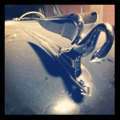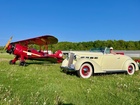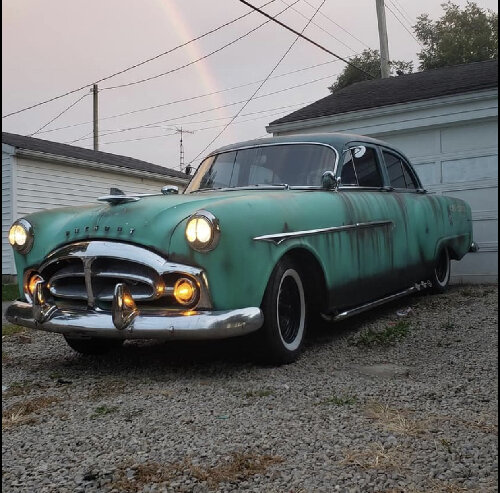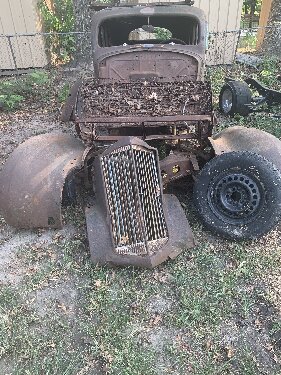|
Re: wiring problems
|
||||
|---|---|---|---|---|
|
Just can't stay away

|
I've found bench power sources to be invaluable when rewriting cars. Having just finished a 53 Patrician with the electro-hydraulic system, being able to power individual circuits without possibly frying the whole harness was tremendously helpful.
Test the switch on the bench with your multi-meter--usually they just get dirty-- and then move on to testing individual wires with your test light. The good thing is that these systems are relatively simple. I'm sure when you find the problem it'll be something incredibly frustrating and simple.
Posted on: 2013/5/23 2:31
|
|||
|
||||
|
Re: temperature problem?
|
||||
|---|---|---|---|---|
|
Just can't stay away

|
There are several price levels of thermostats for your car. All below are 160 degree 54mm thermostats.
Economy: Stant 13006 OE Type: Stant 13356 Gates 33006 Superstat (Premium): Gates 33006S Stant 45356
Posted on: 2013/5/19 1:52
|
|||
|
||||
|
Re: hydraulic lift system- brake fluid or atf
|
||||
|---|---|---|---|---|
|
Just can't stay away

|
ATF, hands down, is the fluid to use. The hydraulic rebuilders won't warranty their rams and hydraulic components for nearly as long if you use brake fluid. Brake fluid absorbs moisture from the atmosphere when exposed to the air, and even in a closed system, like the brake system, it still absorbs enough moisture in two years to lower the boiling point sufficient to require a change in fluid every two years.
BUT the Packard hydroelectric system is open to the atmosphere. Which means that brake fluid is deteriorating from the moment you pour it in. ATF, on the other hand, doesn't do that. The only issue, as BH alluded to, is that hydraulic hoses prior to about 1953 don't hold up well to ATF (they tend to swell). The easy test is to remove any older hoses and soak them in ATF for a day or so. If there's no change, you're good to go. If there is, any convertible top shop can make you a hose, or you can buy new hoses from the specialty vendors. The flush to convert from brake fluid to ATF isn't difficult-- do it just as you would a normal fluid change. To speed things up, I'll exhaust most of the fluid from the system by removing the hose at the farthest hydraulic cylinder and running the pump. Then fill the system with ATF and repeat, cycling all hydraulic components to their most collapsed state, back to fully extended. Empty the system again, fill with ATF, bleed it per the service manual, and you should be good to go.
Posted on: 2013/5/19 1:41
|
|||
|
||||
|
Re: brakes easamatic
|
||||
|---|---|---|---|---|
|
Just can't stay away

|
I've had the luxury of driving four different Packards with Easamatic brakes-- a '52, '53, '54, and '55 -- and I can say with certainty that they are all different, but when set up properly, they work very well. The '52 stops like a modern car-- firm pedal, gentle give, quick return -- whereas the '55 was so touchy that if you didn't watch it, you'd lock the brakes and throw everyone through the windshield. The '53 was somewhere in the middle, that is until the booster failed and started sucking brake fluid into the intake, leaving you hopefully enough fluid to pump up pressure. The 55 turned out to have 2 leaky wheel cylinders, so the shoes would grab suddenly.
Two things are responsible for pedal return-- the spring in the booster unit and the return spring on the brake shoes themselves. Check your drums and shoes to make sure you've got good springs in there.
Posted on: 2013/5/18 1:39
|
|||
|
||||
|
Re: brakes easamatic
|
||||
|---|---|---|---|---|
|
Just can't stay away

|
I've had the luxury of driving four different Packards with Easamatic brakes-- a '52, '53, '54, and '55 -- and I can say with certainty that they are all different, but when set up properly, they work very well. The '52 stops like a modern car-- firm pedal, gentle give, quick return -- whereas the '55 was so touchy that if you didn't watch it, you'd lock the brakes and throw everyone through the windshield. The '53 was somewhere in the middle, that is until the booster failed and started sucking brake fluid into the intake, leaving you hopefully enough fluid to pump up pressure. The 55 turned out to have 2 leaky wheel cylinders, so the shoes would grab suddenly.
Two things are responsible for pedal return-- the spring in the booster unit and the return spring on the brake shoes themselves. Check your drums and shoes to make sure you've got good springs in there.
Posted on: 2013/5/18 1:39
|
|||
|
||||
|
Re: 327 sputtering under acceleration
|
||||
|---|---|---|---|---|
|
Just can't stay away

|
3/8" of plug reach is correct. The proper plugs back in the day were Autolite A7 or Champion J8 according to the 1953 A.E.A. Tune-up chart. The Champions are hard to find these days, and if you want the Autolite plugs, you have to remember that thanks to Ford's purchase of most of the Autolite branding, those plugs happen to now be called MOTORCRAFT A7, which are still available in some places.
The plugs you are using should work, but I've always preferred to go with tried-and-true (and cheap). Autolite 308's work great in my '52 9-main 327, and they're $1.41 each from RockAuto. Champion J12's will work as well, but I've had trouble finding them. I've heard rave reviews on Bosch Super Plus 7915's, mostly because they seem to last longer and they come right out of the box consistently gapped to the proper setting, but I have not tried them myself. Resistor plugs suppress ignition noise, so I recommend them if you have a radio in the car. The gap spec for 1953 is .023-.028, which the factory put more precisely at .025, and that happens to be the approximate setting of the plugs I mentioned above. Erring on the wider side (closer to .028) may be preferable as it will result in a smoother idle; I wouldn't go any narrower than .025. Your timing may be retarded a bit, by the way. At 600 RPM, the centrifugal advance may already be coming into play. The idle speed when setting the timing should be under 450 RPM and above 390 RPM (do not idle the engine below 390 RPM). You can easily check your plug wires with a multimeter. A bad wire will have wildly higher resistance than the rest.
Posted on: 2013/5/17 2:25
|
|||
|
||||
|
Re: Miss at Idle
|
||||
|---|---|---|---|---|
|
Just can't stay away

|
Quote:
In a way, yes, much has been resolved (though not necessarily solved). I've run every diagnostic test suggested here, more methodically than most local mechanics would, and I have concluded three things: -it's not something simple -it's not something I've overlooked (experienced minds haven't suggested anything different than what I've considered) -it's not worth delving into any deeper until it gets worse or there's another symptom I'm happy leaving well enough alone for the time being, which is what I plan to do. Thanks to all who contributed their advice and guidance, I sincerely appreciate it.
Posted on: 2013/4/1 0:48
|
|||
|
||||
|
Re: Miss at Idle
|
||||
|---|---|---|---|---|
|
Just can't stay away

|
To recap: For the most part, it runs smoothly. Not as smoothly as you'd expect a 9-main engine to run, but smoothly enough. But intermittently it has a stutter, as if one of the cylinders fires every other time or two out of three times.
Because it doesn't do it all the time, I've had trouble running timing tests at idle (it seems to behave when I'm at home with my tools). The timing is currently set dead on to spec at 6? btdc.
Posted on: 2013/3/26 15:33
|
|||
|
||||
|
Re: Tire Pressure
|
||||
|---|---|---|---|---|
|
Just can't stay away

|
24-25 psi should be just about right. Because these tires are the same type (bias-ply) as originally specified, you can go by the original recommendation. Bias ply tires have much stiffer sidewalls than radials do, so you can get proper performance with lower pressure.
When choosing pressures, the manufacturer is always trying to balance ride quality, tire wear, and safety. I wouldn't go any lower than 24 psi, but you could go up a bit to 30 psi or so (provided that's under the max, which it should be) and see how the handling and ride compare. An overinflated tire will not make full use of the contact patch, so going to the absolute max pressure is unwise. Jist as an aside, I run radials on my car and have settled on 40 psi as the best radial tire pressure.
Posted on: 2013/3/22 10:45
|
|||
|
||||








